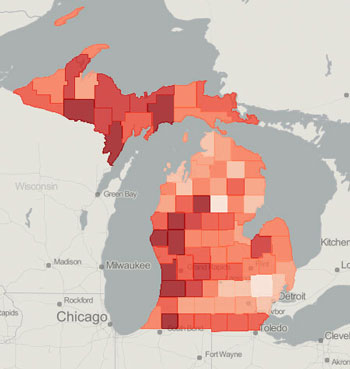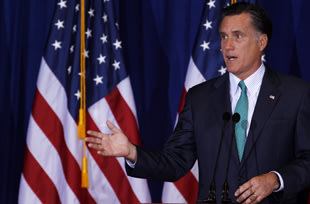The American Economy
Our immense resources a problem?
One fundamental problem with the U.S. economy is one we have had for at least the last fifty years: We have the capacity to produce more than we need. This fundamental fact becomes clearer when one thinks about supply of the basic material needs of food, shelter and clothing. Notwithstanding periodic crop failures, America has more than enough farmland to produce food for our entire population, if necessary. We do not face a realistic possibility of famine—barring some appalling ecological disaster, an explosion or fissure or airborne menace that destroys the honeybee population or irrevocably contaminates our land and water supply.

honeybees
The same goes for shelter and clothing. The U.S. has more than enough construction capability to build houses for our entire population, again barring ecological disaster on a life-threatening scale. We have more than enough resources and manufacturing to clothe our entire population, even if to do so would mean resuscitating underused or abandoned industries. The fundamental fact that we can produce more than we need is one of the causes of our chronic unemployment and underemployment. It is one of the causes of our widespread health problems, obesity being the most obvious example. Ironically it is one of the causes of our ongoing trade deficit. Anyone who genuinely wants to ameliorate unemployment and underemployment in the U.S. has to face the fact that we can produce more, far more, than we need to buy, both of what is essential to survival and of nonessential extras.

Other countries do it, too
This fundamental fact served the United States well in World War II. The nation went into high gear as a patriotic war machine, and immediately began production on a scale not seen before. Some kinds of commerce, construction, production and imports may have been curtailed—not counting the importation of human capital like Albert Einstein, fortunately driven from Nazi Germany by German ignorance, envy and hysterical beliefs about ‘race’. But domestic production ramped up to fill most essential needs, at least within the parameters of knowledge at the time, and there was less hunger in the United States during a horrific world war than there had been shortly before it.

World War II poster
Post-World War II, the same fundamental production capability and natural resources and well-qualified labor force created economic expansion for over twenty-five years, again on a scale not seen before. Public highways, public schools and the private use of birth control all contributed to the development of an immense, self-confident middle class with a reasonable confidence in achieving shelter, education and personal advancement, among other things. The conformity may have been food for satire, the natural environment somewhat strained by missteps and miscalculations, the health of individuals plagued by toxic products from tobacco to thalidomide, but the material benefits of national development became so obvious as to highlight shameful poverty among the elderly and in Appalachia and in historically excluded groups. They also ineluctably exposed ‘separate but equal’ as transparent sham.
In 2012, the same fundamental is working differently, as we know from the massive slump that has resulted from the mortgage derivatives debacle. When we can readily produce more than we need, some people inevitably end up—or start out–doing things that no one wants to pay them to do. And that’s without factoring in imports. I don’t want to go into dispiriting detail here. Most thinking people have already noticed that we have millions of over-qualified Americans laid off, or trying to enter the job market, or underemployed, underpaid or working in lower-skill occupations than they trained for.
Needless to say, the GOP is blaming all the disappointment on President Obama. Hence the election-year rhetoric about ‘jobs’ and ‘putting people to work’. Predictably, Republican campaigns are funded by entities like Big Oil and the airlines, which have no more standing than does the Chamber of Commerce to yell about ‘jobs’, but more on that later.
For now, there are generally three levels of response to the situation outlined above. That it, there are broadly three kinds of response—boiling this down—once the fundamental fact of our immense resources and production capability is acknowledged:
1) Bogus. The first is what might be termed the horrible, or George F. Will, response. This is the pseudo-erudite argument that high production capability inevitably means unemployment. This is the way it is, and it’s hopeless. Nothing to see here, folks; move along. People like Will himself, overcompensated for the reverse of beneficial service to humankind, generally use fancier language to make this unsubstantiated claim, but this is what it boils down to.*
2) Short-term. The second response is the focused, material approach: Let’s expand our overseas markets. A reasonable response–if we recognize that we can, and do, produce more than we need, then it’s logical to look for markets elsewhere. If we can’t consume all our production domestically, and we want markets to sell in, then we should be trying to export. A nice idea as far as it goes, but mostly a) not attempted; and b) problematic when it is attempted. Whatever the problem, dumping tobacco products in emerging markets is not a long-term solution. Unfortunately, for at least the last thirty years we have been exporting ideas and importing products, rather than the other way around.
3) If we can do these things, why don’t we? In the interest of full disclosure, I should state right up front that this would be my response. A partial explanation is that the perspective of ‘the law of supply and demand’ tends to treat wealth of resources as a problem.
More later.
*For right now, Will is with the Boehner-Mitchell crowd in blaming unemployment on the president, but that’s for election year. It’s not his usual or level-of-rest kind of statement.
Side note: If Will weren’t already a syndicated columnist with the Washington Post, he would soon be taken on. Anti-labor are the Post’s cup of tea, where commentary is concerned. They’re popular on ABC News programs, too.

















